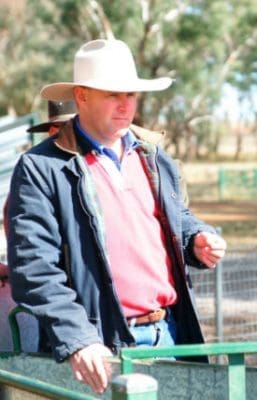AS THE 2019 bull selling season draws to a close, there are some key trends that have emerged from what has been a challenging year for all producers across the country.
Deepening drought conditions across much of the continent has placed extraordinary pressure on the national cow herd, with numbers on-farm dramatically falling as feed and water reserves decline.

Alastair Rayner
Despite the continued reduction in cow numbers, this year’s spring bull selling season was not as tough as many producers first feared. Strong sales with high clearances occurred across breeds in NSW and Victoria, while in the north demand for bulls remained as strong as previous years, with total clearances at major sales and breed events.
A robust slaughter cattle market, driven by strong international demand for Australian beef, helped underpin confidence throughout the year, in spite of paddock conditions.
Reflecting on the trends of the sales, several points have emerged. Demand for proven genetics underpinned many of the sales which recorded strong clearances. In what was described earlier as a “buyers’ market, where producers are picking through catalogues,” it was clear that breeding programs with a strong focus on genetic data and accurate performance records were well rewarded with buyer demand.
CEO of Angus Australia, Peter Parnell reflected on this trend, stating that despite the reduced number of cows in herds across the country, there was “still strong demand for structurally sound Angus bulls with good phenotype and balanced performance figures.” He also noted that while in general, the numbers of bulls sold at auction, and the average sale prices received for Angus bulls were lower than the past couple of years, not every sale followed that trend.
There were several highly successful sales that were either on par or in fact above the results received in recent years.
Some Angus sales continued to defy gravity, including Ross Thompson’s Millah Murrah sale in September averaging $17,200 for 69 bulls.
Herd reductions among bull buyers saw many catalogues offering fewer numbers of bulls than past years. As one noted breeder commented earlier in the year, this meant the sales were generally a much better quality line up of bulls on average, given that the ‘tail’ had been removed.
Andrew Donoghue of Herefords Australia also noted the impact of herd reductions across seedstock and commercial herds. He said that many producers, particularly in northern NSW, were focussed on surviving the drought. This meant many sale offerings were lower in number, but generally represented the pick of the bulls.
Client engagement
Also strongly apparent across the sales in 2019 has been the importance of client engagement and developing a strong relationship with customers across a broader area. For NSW producers, having interstate clients outside severe drought affected areas was vital in achieving strong clearance rates this year. While many sales struggled to clear 60-70pc of bulls this year, and in places less, good marketers tended to find homes for most of their offerings.
Peter Parnell noted that many Angus breeders who had strong sales also “had strong marketing programs beyond their immediate local area.”
Longer term confidence in the industry
While drought conditions continue to impact many areas in Northern Australia, there has also been a strong sense of long-term industry confidence underpinning most northern sales in recent weeks.
Anastasia Fanning, manager of the Australian Brahman Breeders Association in Rockhampton, described much of this confidence as stemming from the strong live export market, as well as domestic demand for cattle.
As with southern Australia, there has been continued reduction in breeding cows in parts of Queensland and the NT, however she noted there were still a lot of breeding cows in herds across the north, and producers continued to purchase bulls to meet their breeding goals.
Ms Fanning highlighted the success of this year’s Rockhampton Brahman Week Sale as an outstanding result for breeders and the breed in a challenging year.
This year’s sale saw 779 bulls offered for an average price of almost $11,000.
How is it possible for such a large multi-vendor sale to achieve such a high average price across so many bulls? There are several parts to the answer. Many of the Brahman Week bulls will in fact be used within internal nucleus herds to breed herd bulls, encouraging those buyers to bid up for genetically superior animals.
Secondly, one of the strengths of the Brahman Week sale is self-limiting nature of entries. Seedstock breeders offering bulls at Brahman Week are restricted through sale regulations to a specific number each year, determined by numbers they sold in earlier years. As result, bull breeders selling at the sale tend to keep their very best young bulls back for the Brahman Week sale. The focus on the best line up from breeders across the country does ensure much interest and demand from buyers across the three days of selling.
The importance of reputation has underpinned the success of many of the stronger Bos Indicus bull sales this year, along with a focus on accurate information on bulls.
While the uptake of Breedplan data is much lower than in temperate breeds, Ms Fanning noted that “producers are looking for as much data as they can obtain, and it’s possibly an area that will grow in coming years.”
Overall for many bull breeders, the major outcomes from a challenging year should be to reflect on the strength of their client relationships as well as their approach to marketing and promotion beyond their immediate locations.
Maintaining a strong focus in the collection of accurate data and provision of genetic performance figures will be a key requirement in what could be another year of breeders being “spoilt for choice” in 2020.
While it is unlikely that may bull breeders will be increasing sale numbers for 2020, it’s possible that limiting the offering and concentrating on producing an even line with “no tail” may become a strategy a number of producers will follow, even when the season breaks.
Alastair Rayner is the Principal of RaynerAg, an agricultural advisory service based in NSW. He regularly attends bull sales to support client purchases and undertakes pre sale selections and classifications. He can be contacted here or through his website www.raynerag.com.au
Genetics Central goes into summer recess
Tonight’s genetics review is the last for 2019, with the weekly report now going into its annual summer recess. Genetics editor Al Rayner will resume weekly genetics coverage at the end of January, in good time for autumn 2020 bull and female season.
Genetics Central is now working on its annual end-of-selling season report on average prices and numbers of bulls sold for major beef breeds across Australia during the 2019 bull selling year. The report will appear in late November, following similar reviews compiled each year since 2011. The summaries provide a handy sequence against which breed progress can be gauged.
Leading up to Christmas, work will also start on compiling the full list of 2020 Upcoming Bull Sales, appearing as a tabulated list in Beef Central’s genetics section. We remind studmasters to submit their 2020 sale dates (via this form), if they are not already provided by respective breed societies.
2020 bull sales promotion
 Stud managers wishing to promote their Autumn 2020 bull sales via ads on Beef Central’s genetics pages, daily email alert or home page early next year should contact business development manager Rod Hibberd (pictured) at rod@beefcentral.com or phone on 0437 870 127. Ad spaces are limited, so make contact early to avoid disappointment.
Stud managers wishing to promote their Autumn 2020 bull sales via ads on Beef Central’s genetics pages, daily email alert or home page early next year should contact business development manager Rod Hibberd (pictured) at rod@beefcentral.com or phone on 0437 870 127. Ad spaces are limited, so make contact early to avoid disappointment.
